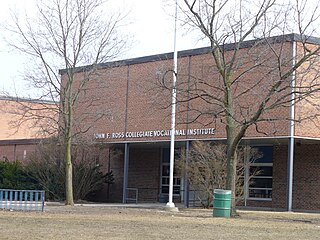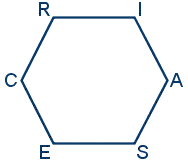Occupational therapists (OTs) are health care professionals specializing in occupational therapy and occupational science. OTs and occupational therapy assistants (OTAs) use scientific bases and a holistic perspective to promote a person's ability to fulfill their daily routines and roles. OTs have training in the physical, psychological, and social aspects of human functioning deriving from an education grounded in anatomical and physiological concepts, and psychological perspectives. They enable individuals across the lifespan by optimizing their abilities to perform activities that are meaningful to them ("occupations"). Human occupations include activities of daily living, work/vocation, play, education, leisure, rest and sleep, and social participation.

Vocational education is education that prepares people to a skilled craft as an artisan, trade as a tradesperson, or work as a technician. Vocational Education can also be seen as that type of education given to an individual to prepare that individual to be gainfully employed or self employed with requisite skill. Vocational education is known by a variety of names, depending on the country concerned, including career and technical education, or acronyms such as TVET and TAFE.

A tradesperson is a skilled worker that specializes in a particular trade. Tradespeople usually gain their skills through work experience, on-the-job training, an apprenticeship program or formal education.

A blue-collar worker is a working class person who performs manual labor and/or skilled trades. Blue-collar work may involve skilled or unskilled labor. The type of work may involve manufacturing, warehousing, mining, excavation, electricity generation and power plant operations, electrical construction and maintenance, custodial work, farming, commercial fishing, logging, landscaping, pest control, food processing, oil field work, waste collection and disposal, recycling, construction, maintenance, shipping, driving, trucking, and many other types of physical work. Blue-collar work often involves something being physically built or maintained.

Occupational therapy (OT) is a healthcare profession. It involves the use of assessment and intervention to develop, recover, or maintain the meaningful activities, or occupations, of individuals, groups, or communities. The field of OT consists of health care practitioners trained and educated to improve mental and physical performance. Occupational therapists specialize in teaching, educating, and supporting participation in any activity that occupies an individual's time. It is an independent health profession sometimes categorized as an allied health profession and consists of occupational therapists (OTs) and occupational therapy assistants (OTAs). While OTs and OTAs have different roles, they both work with people who want to improve their mental and or physical health, disabilities, injuries, or impairments.
A skill is the learned ability to act with determined results with good execution often within a given amount of time, energy, or both. Skills can often be divided into domain-general and domain-specific skills. For example, in the domain of work, some general skills would include time management, teamwork and leadership, self-motivation and others, whereas domain-specific skills would be used only for a certain job. Skill usually requires certain environmental stimuli and situations to assess the level of skill being shown and used.
The Standard Occupational Classification (SOC) System is a United States government system of classifying occupations. It is used by U.S. federal government agencies collecting occupational data, enabling comparison of occupations across data sets. It is designed to cover all occupations in which work is performed for pay or profit, reflecting the current occupational structure in the United States. The 2010 SOC includes 840 occupational types.

The Holland Codes or the Holland Occupational Themes (RIASEC) refers to a taxonomy of interests based on a theory of careers and vocational choice that was initially developed by American psychologist John L. Holland.

Job analysis is a family of procedures to identify the content of a job in terms of the activities it involves in addition to the attributes or requirements necessary to perform those activities. Job analysis provides information to organizations that helps them determine which employees are best fit for specific jobs.
Allied health professions are health care professions that provide a range of diagnostic, technical, therapeutic, and support services in connection with health care. Their services are allied with and support the work of a number of other professions not considered allied health professions, such as medicine, nursing, dentistry, optometry, pharmacy, and others listed below as "excluded professions".

The Dictionary of Occupational Titles or D-O-T (DOT) refers to a publication produced by the United States Department of Labor which helped employers, government officials, and workforce development professionals to define over 13,000 different types of work, from 1938 to the late 1990s. The DOT was created by job analysts who visited thousands of US worksites to observe and record the various types of work, and what was involved. Innovative at the time, the DOT included information still used today in settling EEO and Workers Comp claims, like the physical abilities required to perform that occupation, and the time and repetitiveness of those physical actions.

The Selected Characteristics of Occupations (SCO) is a companion volume to the U.S. Department of Labor's Dictionary of Occupational Titles, Revised Fourth Edition, published in 1991. These volumes were intended to provide a detailed representation of thousands of individual occupations in the United States, for the purpose of occupational information, occupational exploration, and job placement.
Occupational rehabilitation is the science and practices of returning injured workers to a level of daily work activities that is appropriate to their functional and cognitive capacity related to their position of which may be influenced by the severity of a worker's injuries.
The Occupational Information Network (O*NET) is a free online database that contains hundreds of job definitions to help students, job seekers, businesses and workforce development professionals to understand today's world of work in the United States. It was developed under the sponsorship of the US Department of Labor/Employment and Training Administration (USDOL/ETA) through a grant to the North Carolina Employment Security Commission during the 1990s. John L. Holland's vocational model, often referred to as the Holland Codes, is used in the "Interests" section of the O*NET.
National Occupational Standards (NOS), also known as professional standards, specify UK standards of performance that people are expected to achieve in their work, and the knowledge and skills they need to perform effectively.
A dead-end job is a job where there is little or no chance of career development and advancement into a better position. If an individual requires further education to progress within their firm that is difficult to obtain for any reason, this can result in the occupation being classified as a dead-end position. Based on human resources and career strategist Toni Howard Lowe, some individuals who have worked for the same company for several years may not be privy to the signs that they are currently employed in a dead-end job.

Individual psychological assessment (IPA) is a tool used by organizations to make decisions on employment. IPA allows employers to evaluate and maintain potential candidates for hiring, promotion, and development by using a series of job analysis instruments such as position analysis questionnaires (PAQ), occupational analysis inventory (OAI), and functional job analysis (FJA). These instruments allow the assessor to develop valid measures of intelligence, personality tests, and a range of other factors as means to determine selection and promotion decisions. Personality and cognitive ability are good predictors of performance. Emotional Intelligence helps individuals navigate through challenging organizational and interpersonal encounters. Since individual differences have a long history in explaining human behavior and the different ways in which individuals respond to similar events and circumstances, these factors allow the organization to determine if an applicant has the competence to effectively and successfully do the work that the job requires. These assessments are administered throughout organizations in different forms, but they share one common goal in the selection process, and that is the right candidate for the job.
The Vocational Qualification Transfer System (VQTS) model is a proposal for a structured description of work-related competences. The core elements are the Competence Matrix and the Competence Profiles. A Competence Matrix displays competences structurally in a table according to core work tasks in a specific occupational field and the progress of competence development. Competence Profiles are formed from individual parts of this Competence Matrix. In the context of ECVET the VQTS project sought to support the transnational mobility of learners. A Competence Matrix can be used for the development of qualifications, training programmes, and job profiles, as well as for human resource planning, the allocation of qualifications to the Qualifications Framework, and for developing higher permeability between vocational education and higher education.

Work or labor is the intentional activity people perform to support the needs and wants of themselves, others, or a wider community. In the context of economics, work can be viewed as the human activity that contributes towards the goods and services within an economy.
The Standard Occupational Classification, often abbreviated as the SOC, is the system used by the United Kingdom's Office for National Statistics (ONS) to classify people for statistical purposes according to their job. Under this system, a job is defined as "a set of tasks or duties to be carried out by one person". The SOC classifies jobs according to the level and specialisation of skill. The SOC was introduced in 1990. It has undergone several revisions; the latest, SOC 2020, includes nine major groups of occupations, each broken down into smaller units: there are 26 sub-major groups, 104 minor groups and 412 unit groups. The groups are designed to be as similar as possible to the International Standard Classification of Occupations 2008.